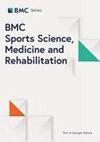青壮年急性力量锻炼后屈肘和伸膝对血管和血液动力学参数以及动脉僵化指数的不同影响
IF 2.8
3区 医学
Q1 REHABILITATION
引用次数: 0
摘要
不同类型的运动,无论是急性运动还是慢性运动,都会对中枢血流动力学、动脉僵化和心脏功能产生不同的影响。在这项研究中,我们旨在比较急性屈肘(EFlex)和伸膝(KExt)运动对健康年轻人的血管和血液动力学参数以及动脉僵化指数的影响。青壮年(20 至 39 岁)接受随机肌力测试,以获得肘关节屈曲(EFlex)和膝关节伸展(KExt)的单次最大肌力(1RM)。最短间隔 48 小时后,使用 Mobil-O-Graph® (Mobil-O-Graph,德国 IEM 公司)在三个时间点对心血管参数进行评估:基线(运动前)、肘关节屈伸或膝关节伸展运动后(负荷相当于 1RM 的 50%)(T0)和休息 15 分钟后(T15)。运动后(T0),KExt 的外周收缩压、外周脉压、中心收缩压和中心脉压明显高于 EFlex(分别为 Δ 3.13;Δ 3.06;Δ 5.65;Δ 5.61 mmHg)。与 EFlex(分别为 Δ 4.2 毫升;Δ 0.27 毫升/分钟和 0.14 升/分钟*1/平方米)相比,KExt 术后立即收缩压容积、心输出量和心脏指数均明显增加。与 EFlex 相比,KExt 在 T0 时的反射系数和脉搏波速度也明显更高(分别为 Δ 8.59 和 Δ 0.12 米/秒)。我们的研究结果表明,肌肉质量对 EFlex 和 KExt 术后立即评估的血管和血流动力学参数的影响不同。 此外,我们的研究首次表明,反射系数(一种评估外周反射波大小的指标)仅受 KExt 的影响。本文章由计算机程序翻译,如有差异,请以英文原文为准。
Differential contribution of elbow flexion and knee extension on vascular and hemodynamic parameters and arterial stiffness indices after acute strength exercise in young adults
Different types of exercise, performed acutely or chronically, have different repercussions on central hemodynamics, arterial stiffness, and cardiac function. In this study, we aim to compare the effects of acute elbow flexion (EFlex) and knee extension (KExt) exercises on vascular and hemodynamic parameters and arterial stiffness indices in healthy young adults. Young adults (20 to 39 years) underwent randomized muscle strength tests to obtain 1 repetition maximum (1RM) for elbow flexion (EFlex) and knee extension (KExt). After a minimum interval of 48 h, cardiovascular parameters were assessed using Mobil-O-Graph® (Mobil-O-Graph, IEM, Germany) at three-time points: at baseline (before exercise), immediately after elbow flexion or knee extension exercises with a load corresponding to 50% of 1RM (T0) and after 15 min of rest (T15). Immediately after exercise (T0), peripheral systolic blood pressure, peripheral pulse pressure, central systolic blood pressure, and central pulse pressure were significantly higher in KExt than EFlex (Δ 3.13; Δ 3.06; Δ 5.65; Δ 5.61 mmHg, respectively). Systolic volume, cardiac output, and cardiac index were significantly higher immediately after KExt when compared with EFlex (Δ 4.2 ml; Δ 0.27 ml/min and 0.14 l/min*1/m2, respectively). The reflection coefficient and the pulse wave velocity were also significantly higher at T0 in KExt compared to EFlex ( Δ 8.59 and Δ 0.12 m/sec, respectively). Our results show differential contribution of muscle mass in vascular and hemodynamic parameters evaluated immediately after EFlex and KExt. In addition, our study showed for the first time that the reflection coefficient, an index that evaluates the magnitude of the reflected waves from the periphery, was only affected by KExt.
求助全文
通过发布文献求助,成功后即可免费获取论文全文。
去求助
来源期刊

BMC Sports Science Medicine and Rehabilitation
Medicine-Orthopedics and Sports Medicine
CiteScore
3.00
自引率
5.30%
发文量
196
审稿时长
26 weeks
期刊介绍:
BMC Sports Science, Medicine and Rehabilitation is an open access, peer reviewed journal that considers articles on all aspects of sports medicine and the exercise sciences, including rehabilitation, traumatology, cardiology, physiology, and nutrition.
 求助内容:
求助内容: 应助结果提醒方式:
应助结果提醒方式:


